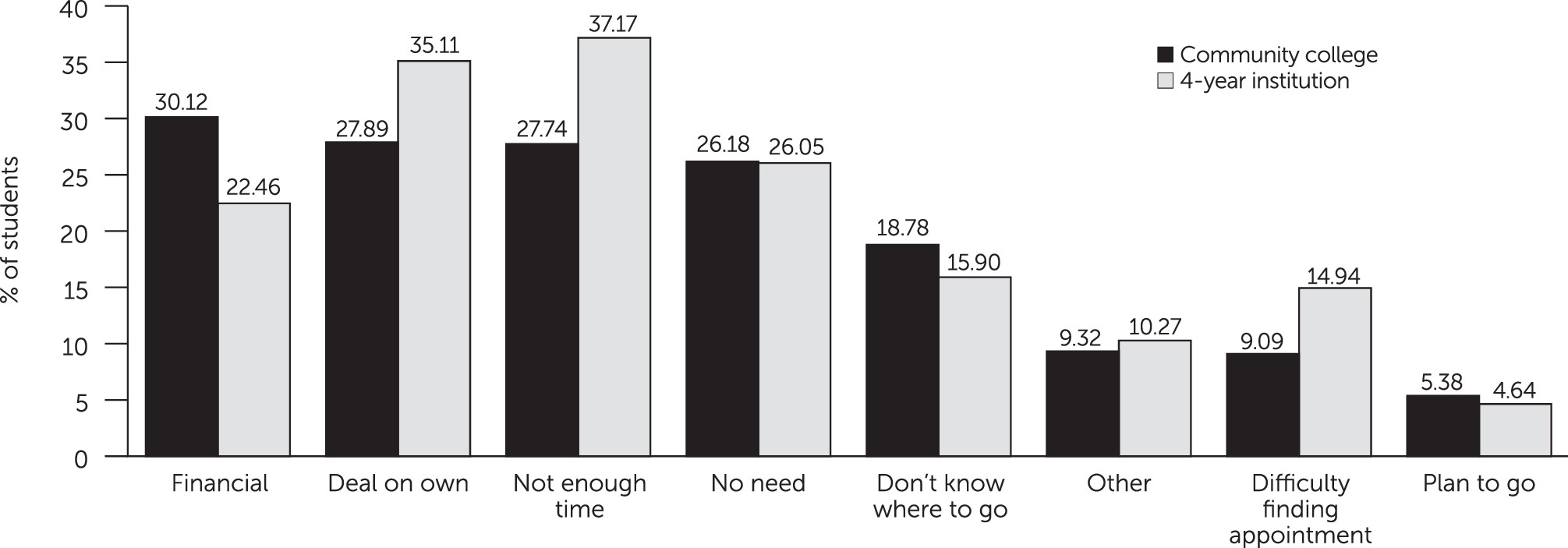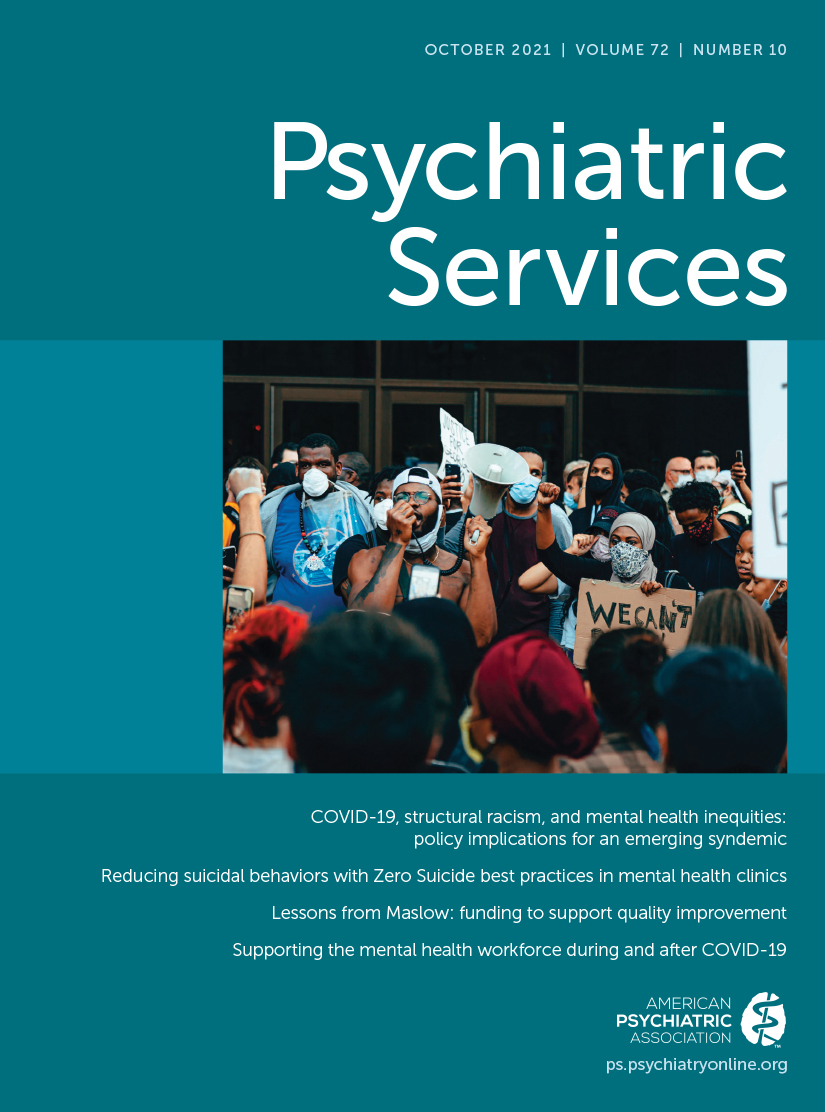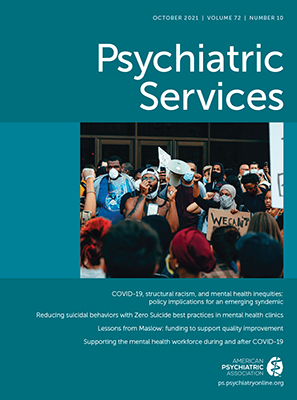Mental Health Conditions Among Community College Students: A National Study of Prevalence and Use of Treatment Services
Abstract
Objective:
Methods:
Results:
Conclusions:
HIGHLIGHTS
Methods
Data
Measures
Prevalence of mental health problems.
Academic performance.
Service use.
Individual characteristics.
Statistical Analysis
Results
Sample
| Characteristic | Community college students (N=10,089) | 4-year college students (N=95,711) | |||
|---|---|---|---|---|---|
| N | % | N | % | p | |
| Age (M±SD years) | 26.1±.12 | 21.3±.02 | <.001 | ||
| 18–22 | 5,113 | 52.2 | 83,175 | 85.1 | <.001 |
| 23–29 | 2,382 | 23.1 | 8,540 | 10.2 | <.001 |
| ≥30 | 2,594 | 24.8 | 3,996 | 4.7 | <.001 |
| Gender identity | |||||
| Female | 7,180 | 57.2 | 64,764 | 56.2 | .2 |
| Male | 2,704 | 40.8 | 28,305 | 40.5 | .7 |
| Transgender or gender nonconforming | 205 | 1.9 | 2,642 | 3.3 | <.001 |
| Race-ethnicity | |||||
| White | 6,387 | 60.7 | 62,124 | 63.6 | <.001 |
| Black | 875 | 8.9 | 5,208 | 7.6 | .001 |
| Asian | 481 | 4.1 | 10,147 | 9.8 | <.001 |
| Latinx | 1,081 | 13.4 | 5,908 | 6.2 | <.001 |
| Multiracial | 898 | 9.2 | 9,663 | 9.7 | .2 |
| Other | 283 | 3.1 | 1,461 | 1.8 | <.001 |
| Arab or Arab American | 84 | .7 | 1,200 | 1.3 | <.001 |
| Sexual orientation | |||||
| Heterosexual | 8,221 | 83.5 | 76,585 | 79.3 | <.001 |
| Lesbian, gay, bisexual, queer | 1,702 | 16.5 | 18,683 | 20.7 | |
| Current financial stress | |||||
| Always | 2,198 | 21.3 | 12,040 | 14.2 | <.001 |
| Often | 2,838 | 27.7 | 22,182 | 24.2 | <.001 |
| Sometimes | 3,507 | 35.6 | 33,479 | 35.1 | .4 |
| Rarely | 1,180 | 12.3 | 20,038 | 19.6 | <.001 |
| Never | 285 | 3.2 | 7,157 | 6.9 | <.001 |
| Past financial stress | |||||
| Always | 1,783 | 18.0 | 7,552 | 8.9 | <.001 |
| Often | 2,089 | 21.5 | 14,213 | 15.9 | <.001 |
| Sometimes | 2,885 | 28.7 | 24,693 | 26.8 | .003 |
| Rarely | 2,211 | 21.8 | 29,960 | 30.6 | <.001 |
| Never | 1,038 | 10.0 | 18,461 | 17.9 | <.001 |
Prevalence
| Age group | Community college students | 4-year college students | |||
|---|---|---|---|---|---|
| N | % | N | % | p | |
| All studentsb | |||||
| Depression | 3,568 | 37.9 | 31,877 | 37.3 | .4 |
| Anxiety | 3,112 | 33.0 | 27,125 | 31.3 | .01 |
| Eating disorder | 2,433 | 24.5 | 22,874 | 24.8 | .7 |
| Nonsuicidal self-injury | 1,871 | 19.7 | 22,030 | 26.6 | <.001 |
| Suicidal ideation | 1,368 | 14.7 | 12,229 | 14.7 | .96 |
| One or more mental health problemsc | 5,488 | 53.5 | 52,575 | 55.0 | .04 |
| Academic performance affected | 7,438 | 72.9 | 74,115 | 78.0 | <.001 |
| Ages 18–22d | |||||
| Depression | 2,059 | 42.0 | 27,567 | 37.3 | <.001 |
| Anxiety | 1,766 | 36.3 | 23,548 | 31.4 | <.001 |
| Eating disorder | 1,388 | 27.5 | 20,170 | 25.2 | .007 |
| Nonsuicidal self-injury | 1,280 | 27.1 | 19,973 | 28.0 | .3 |
| Suicidal ideation | 847 | 18.2 | 10,801 | 15.0 | <.001 |
| One or more mental health problemsc | 3,087 | 58.1 | 45,958 | 55.3 | .005 |
| Academic performance affected | 3,937 | 75.8 | 64,545 | 78.2 | .007 |
| Ages 23–29e | |||||
| Depression | 873 | 39.8 | 3,241 | 41.5 | .3 |
| Anxiety | 789 | 35.4 | 2,708 | 34.4 | .6 |
| Eating disorder | 567 | 24.5 | 1,969 | 24.2 | .8 |
| Nonsuicidal self-injury | 406 | 17.0 | 1,678 | 22.7 | <.001 |
| Suicidal ideation | 308 | 14.0 | 1,134 | 15.7 | .2 |
| One or more mental health problemsc | 1,336 | 55.6 | 4,883 | 57.8 | .2 |
| Academic performance affected | 1,782 | 74.8 | 6,794 | 80.6 | <.001 |
| Ages ≥30f | |||||
| Depression | 636 | 28.0 | 1,069 | 28.5 | .7 |
| Anxiety | 557 | 24.0 | 869 | 22.0 | .2 |
| Eating disorder | 478 | 18.5 | 735 | 19.2 | .6 |
| Nonsuicidal self-injury | 185 | 7.4 | 379 | 10.4 | .004 |
| Suicidal ideation | 213 | 8.3 | 294 | 8.4 | .9 |
| One or more mental health problemsc | 1,065 | 41.9 | 1,734 | 42.7 | .6 |
| Academic performance affected | 1,719 | 65.1 | 2,776 | 69.1 | .01 |
Service Use
| Age group | Community college students | 4-year college students | |||
|---|---|---|---|---|---|
| N | % | N | % | p | |
| All studentsb | |||||
| Therapy | 1,565 | 30.0 | 19,866 | 39.5 | <.001 |
| Psychotropic medication | 1,762 | 32.2 | 15,766 | 32.5 | .7 |
| On-campus service use | 263 | 5.4 | 11,678 | 23.4 | <.001 |
| Ages 18–22c | |||||
| Therapy | 780 | 25.3 | 17,451 | 39.7 | <.001 |
| Psychotropic medication | 815 | 25.8 | 13,308 | 31.5 | <.001 |
| On-campus service use | 145 | 5.4 | 10,696 | 24.7 | <.001 |
| Ages 23–29d | |||||
| Therapy | 400 | 33.3 | 1,705 | 36.3 | .2 |
| Psychotropic medication | 478 | 36.6 | 1,704 | 36.7 | .95 |
| On-campus service use | 64 | 6.1 | 800 | 17.4 | <.001 |
| Ages ≥30e | |||||
| Therapy | 385 | 39.5 | 710 | 43.2 | .2 |
| Psychotropic medication | 469 | 45.5 | 754 | 44.0 | .6 |
| On-campus service use | 54 | 4.6 | 182 | 10.0 | <.001 |

Discussion
Conclusions
Footnote
Supplementary Material
- View/Download
- 143.80 KB
References
Information & Authors
Information
Published In
History
Keywords
Authors
Funding Information
Metrics & Citations
Metrics
Citations
Export Citations
If you have the appropriate software installed, you can download article citation data to the citation manager of your choice. Simply select your manager software from the list below and click Download.
For more information or tips please see 'Downloading to a citation manager' in the Help menu.
View Options
View options
PDF/EPUB
View PDF/EPUBLogin options
Already a subscriber? Access your subscription through your login credentials or your institution for full access to this article.
Personal login Institutional Login Open Athens loginNot a subscriber?
PsychiatryOnline subscription options offer access to the DSM-5-TR® library, books, journals, CME, and patient resources. This all-in-one virtual library provides psychiatrists and mental health professionals with key resources for diagnosis, treatment, research, and professional development.
Need more help? PsychiatryOnline Customer Service may be reached by emailing [email protected] or by calling 800-368-5777 (in the U.S.) or 703-907-7322 (outside the U.S.).

